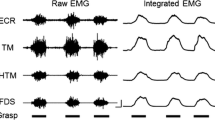Abstract
Afferent activity in thin myelinated and unmyelinated cutaneous nerve fibers was analyzed by an impulse collision method and by methods improving the signal-to-noise ratio in the record of the antidromic action potential. The following groups were distinguished among the thin myelinated and unmyelinated nerve fibers on the basis of the results of investigation of conduction velocities, thresholds of electrical excitation, and response to mechanical stimulation: Aδ 1 (conduction velocity 30-14 m/sec) — a relatively larger number of these fibers conducts excitation in response to weak mechanical stimulation; Aδ 2 (14–4.0 m/sec) — the receptors of these fibers are more easily excited by a strong stimulus; a group of "mixed" fibers, containing myelinated and unmyelinated nerve fibers (4–2 m/sec), conducting excitation in response to both types of mechanical stimulation; C1 (2.0–1.0 m/sec) — a fairly large number of these unmyelinated fibers conducts impulses in response to weak mechanical stimulation; C2 (1.0–0.15 m/sec) the majority of fibers of this group is connected with receptors requiring strong mechanical stimulation for their excitation.
Similar content being viewed by others
Literature cited
A. I. Esakov, "Some peripheral mechanisms of regulation of receptor activity," Abstracts of Proceedings of a Symposium on Tissue Reception [in Russian], Leningrad (1974), pp. 54–61.
A. V. Zeveke and O. S. Gladysheva, "Changes in the frequency spectrum in myelinated afferent Aδ 1 fibers in response to stimulation of cutaneous mechanoreceptors," Dokl. Akad. Nauk SSSR,189, 1150 (1969).
A. V. Zeveke, V. I. Myaderov, V. A. Utkin, and V. L. Shaposhnikov, "Myelinated fibers of a cat cutaneous nerve with slow conduction velocity," Byull. Éksperim. Biol. Med.,76, No. 8, 6 (1973).
A. V. Zeveke, V. I. Myaderov, V. A. Utkin, and V. L. Shaposhnikov, "Conduction velocities in unmyelinated cutaneous nerve fibers," Byull. Éksperim. Biol. Med.,76, No. 9, 6 (1973).
V. L. Shaposhnikov, "Some physiological characteristics of myelinated and unmyelinated fibers with very low conduction velocity," Neirofiziologiya,6, 542 (1974).
O. W. Beek, H. O. Handwerker, and M. Zimmermann, "Nervous outflow from the cat's foot during noxious radiant heat stimulation," Brain Res.,67, 373 (1974).
P. Bessou and E. R. Perl, "Response of cutaneous sensory units with unmyelinated fibers to noxious stimuli" J. Neurophysiol.,32, 1025 (1969).
A. G. Brown and A. Iggo, "Hair follicle receptors with myelinated afferent nerve fibres," J. Physiol. (London),172, 33P (1964).
A. G. Brown and R. E. Hayden, "The distribution of cutaneous receptors in the rabbit's hind limb and differential electrical stimulation of their axons," J. Physiol. (London),213, 495 (1971).
P. R. Burgess, D. Petit, and R. M. Warren, "Receptor types in cat hairy skin supplied by myelinated fibers," J. Neurophysiol.,31, 833 (1968).
P. R. Burgess, "Pattern of discharge evoked in cutaneous nerve and their significance for sensation," Advances Neurol.,4, 11 (1974).
M. R. Chambers, K. H. Andres, M. V. Duering, and A. Iggo, "The structure and function of slowly adapting type II mechanoreceptors in hairy skin," Quart. J. Exp. Physiol.,57, 417 (1972).
W. W. Douglas and J. M. Ritchie, "A technique for recording functional activity in specific groups of medullated and nonmedullated fibres in whole nerve trunks," J. Physiol. (London),138, 19 (1957).
W. W. Douglas and J. M. Ritchie, "The sensory function of the nonmyelinated afferent nerve fibres from the skin" in: Pain and Itch. Nervous Mechanisms, Churchill, London (1959), pp. 41–59.
K. Floyd and J. F. Morrison, "Splanchnic slowly adapting mechanoreceptors in dogs and sheep," J. Physiol. (London),237, 23P (1974).
H. S. Gasser, "Unmedullated fibers originating in dorsal root ganglia," J. Gen. Physiol.,33, 651 (1950).
Y. Grossman, M. E. Spira, and I. Parnas, "Differential flow of information into branches of a single axon," Brain Res.,64, 379 (1973).
H. Hensel and A. Iggo, "Analysis of cutaneous warm and cold fibres in primates," Pflügers Arch.,329, 1 (1971).
K. W. Horch, D. Whitehorn, and P. R. Burgess, "Impulse generation in type I cutaneous mechanoreceptors," J. Neurophysiol.,37, 267 (1974).
C. C. Hunt and A. K. McIntyre, "An analysis of fibre diameter and receptor characteristics of myelinated cutaneous afferent fibres in cat," J. Physiol. (London),153, 99 (1960).
A. Iggo, "An electrophysiological analysis of afferent fibres in primate skin," Acta Neuroveg.,24, 225 (1963).
W. Koll, J. Haase, R. M. Schütz, and B. Mülberg, "Reflexentladungen der tiefspinalen Kats durch afferent Impulse aus hochschnelligen nociceptiven A Fasern (post δ Fasern) und aus C Fasern cutaner Nerven," Arch. Ges. Physiol.,272, 270 (1961).
U. Lindblom, "Excitability and functional organization within a peripheral tactile unit," Acta Physiol. Scand.,44, 5 (1958).
U. Lindblom and D. N. Tapper, "Integration of impulse activity in peripheral sensory unit," Exptl. Neurol.,15, 63 (1966).
S. Nakahara, "Generation of efferent and antidromic impulses in palatinus nerve of frog," Takuoka Acta Med.,63, 25 (1972).
B. Y. Nilsson, "The mechanoreceptors of the sinus hair organ on the cat's foreleg," Symposium: Tissue Reception, Leningrad (1974), pp. 113–130.
A. S. Paintal, "A comparison of the nerve impulses of mammalian nonmedullated fibres with those of the smallest diameter medullated fibres," J. Physiol. (London),193, 523 (1967).
E. R. Perl, "Myelinated afferent fibres innervating the primate skin and their response to noxious stimuli," J. Physiol. (London),197, 593 (1968).
S. W. Ranson and N. K. Davenport, "Sensory unmyelinated fibers in the spinal nerves," Am. J. Anat.,48, 331 (1931).
D. C. Spray, "Characteristics, specificity, and efferent control of frog cutaneous cold receptor," J. Physiol. (London),237, 15 (1974).
D. Whitehorn and P. R. Burgess, "Changes in polarization of certain branches of myelinated mechanoreceptor and nociceptor fibers during noxious and innocuous sitmulation of the skin," J. Neurophysiol.,36, 216 (1973).
Y. Zottermann, "Touch, pain and tickling: an electrophysiological investigation on cutaneous sensory nerves," J. Physiol. (London),95, 1 (1939).
Additional information
Research Institute of Applied Mathematics and Cybernetics, N. I. Lobachevskii State University, Gor'kii. Translated from Neirofiziologiya, Vol. 8, No. 1, pp. 67–75, January–February, 1976.
Rights and permissions
About this article
Cite this article
Shaposhnikov, V.L., Zeveke, A.V. Afferent activity in thin myelinated and unmyelinated cutaneous nerve fibers during mechanical stimulation of skin receptors. Neurophysiology 8, 58–65 (1976). https://doi.org/10.1007/BF01065240
Received:
Issue Date:
DOI: https://doi.org/10.1007/BF01065240




